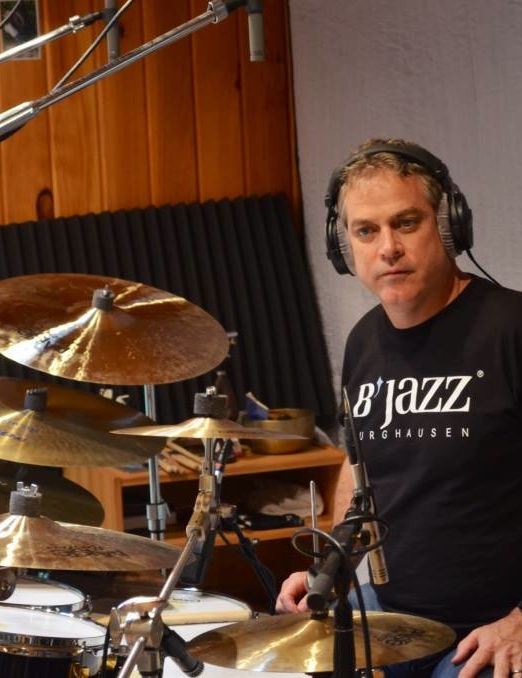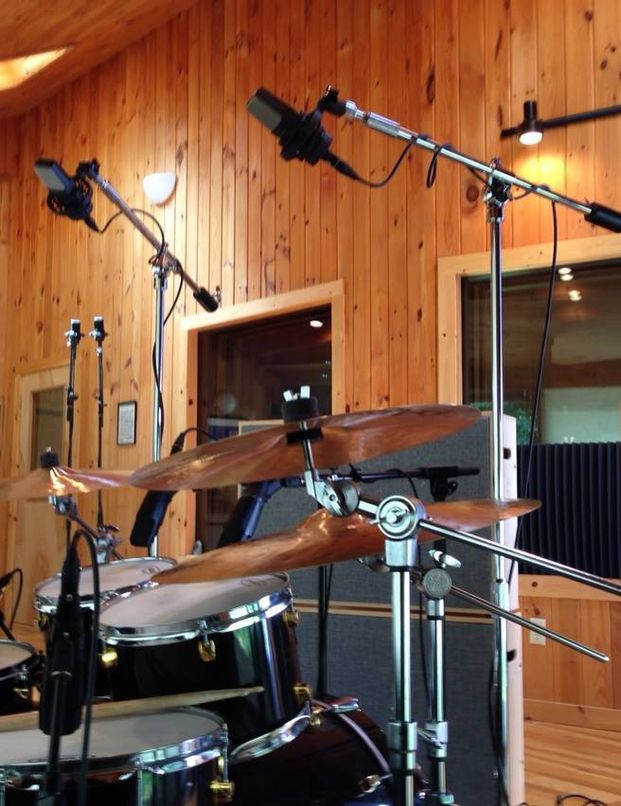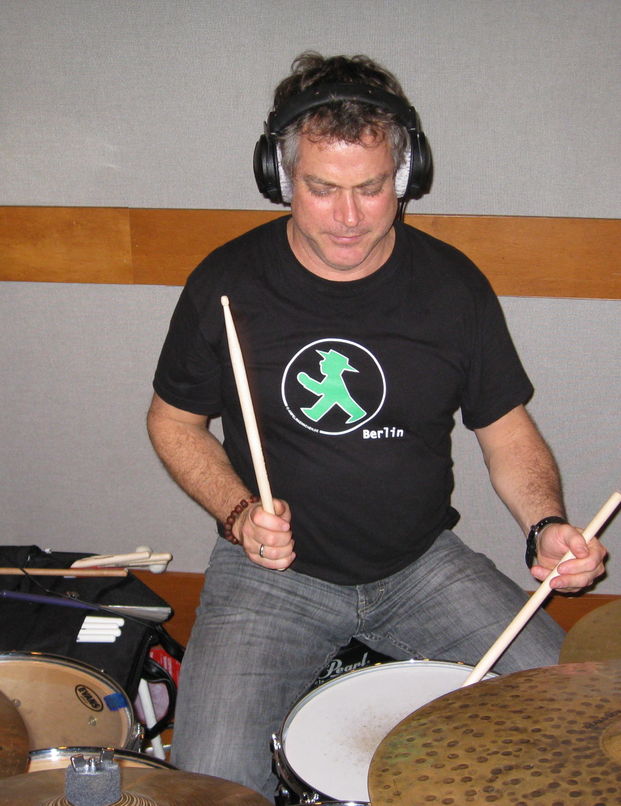Karl Latham is one of the world's most respected drummers. Although his forté is very much in jazz music world, he is just as big a fan of rock music as he is John Coltrane! He also lives in a very unique home in Warwick, NY, in the house that once belonged to Grammy-winning bassist, Mark Egan - perhaps the most recorded fretless bass player in history. It boasts a recording studio designed by the legendary John Stork, and his closest neighbour is a vacant 500-acre parcel of land. It's easy to understand why Latham cites his location as the perfect place to make music: silent for most of the day, aside from the occasional 777 making its descent into Newark Airport in the distance.
“I work with so many genres, man,” beams Latham, adding that this ties in with his 'very interesting life' and is also reflective of his personality. “I am a Gemini, so I play everything! Rock groups, latin jazz, brazilian jazz; somehow I ended up in the modern jazz area, as in the early '90s I did the gig with the bassist of the Dizzie Gillespie Band. He is now leader of that band, and he was best man at my wedding, in fact! He tried to make me one of those great jazz drummers, but the thing is, I like Foos and Metallica as much as I like John Coltrane! [laughs] I grew up listening to a lot of European artists and avant-garde music, way more than bebop and straight ahead jazz.”
I ask Latham about some of his recording projects, which are eclectic, to say the least, and have often involved creating special adaptations of leading artists' work.
“I have many classical influences, rock influences, and some improv, but not really american roots-based music, so I play with Mark Egan as a result, one of the best bassists in world,” Latham explains. “I am a serious Björk fanatic, and when her Volta album came out [in 2007] with Earth Intruders, and I See Who You Are, as soon as I heard it, I knew I wanted to cover it! I had covered Pagan Poetry on an earlier Björk record, but it was just a jazz treatment. So I waited until I found the collection of people that would resonate with her concepts, and didn't let anyone know what songs we were recording. It was me and Mark, Nick Rolfe on keyboards, and then Ryan Cardiaux, a great trumpet player. So I got studio time here in the States, and sent the songs the day before the session! We went in, I played the songs on the iPhone in the middle of the big playing room, and said, 'what do you want to make of this?' And that was that. I wanted to capture the deeper, intuitive feelings within the music, as Björk speaks to me. She is my favourite female vocalist.”
This was back in 2013, and the project was called Constellations, a quite beautiful recording, well worth checking out. Latham describes the process as “getting that stream of consciousness, getting way out of the thinking mind”. He also believes that 100 years from now, people will look back and say Björk was, in fact, an oracle. This is one very spiritual and truly passionate musician.
Living Standards
We move onto Latham's most recent recording project, Living Standards, an album he's put together 'for the people', he explains.
“I want anybody that hears it to go, 'yeah that's cool', and let it bring something to their life: a beauty, or maybe it just makes them move, or whatever,” he says. “Living Standards includes Day Tripper, Tax Man, Neil Young's Cinammon Girl as an amazing waltz ballad – you gotta hear it! And White Rabbit on a mellow guitar, White Room, Us and Them by Pink Floyd, Riders on the Storm, Tomorrow Never Knows. Just amazing songs with amazing players, basically.”
Somewhat of a departure from the standards he's played so many times, then? Or not...
“To me, Cinammon Girl and White Rabbit are standards, you know? Day Tripper has one of the greatest riffs you'll ever here. What's better?”
A fair point, well argued! So what about capturing the audio, then? Latham has already told me at this point that he has tie lines throughout his home, so the house is basically set up to record wherever he is.
“Yeah, the entire house is basically wired to record anywhere,” he confirms, with a smile. “I still use Pro Tools as my capture piece, and to mix, but whenever the first RME Fireface came out, I was front of the line to get one, and I have stuck with that brand ever since. I had the Fireface 800, and when I came into this house, which also has a recording studio designed by John Stork, I realised I could work anywhere. I have a huge mixing room, a loft with tie lines, a living room has tie lines, and there is also a booth.
“This Studio is a gift from the universe... Somehow, it came to me! So then I wanted to upgrade. Everyone was moving to the Universal Apollo [interface], and I have a great relationship with a music store called Alto Music out here in the US, so I called their tech guy and asked him what he thought. He said, 'Karl, you'll hear the latency in the Apollo, keep your Fireface.' He said it's only one in 10,000 people that would hear this problem, but I was one of them! [laughs] He said I would hear it as a phasing issue, so I thought, ok, I'll talk to RME.”
So Latham sent a blind email to RME, explaining that he wanted to upgrade, that he loved their products, and that he was going to buy something anyway, but was there a chance of some kind of relationship? There was, of course.
“Richard de Clemente at RME sent me an email back saying he not only knew who I was, but he was a fan. I couldn't believe it!” Latham laughs. “He sent me the Fireface UFX – and now the entire studio runs on it. I use it for a clock, and for all the recording.”
Living Standards was all recorded using the UFX, as will Latham's next project, Big Funk. At any one time, he is running 20 channels, and he can get even more than that if he needs to.
“I am bringing in eight channels of all these boutique preamps in through Lightpipe; I have five Neve clones, and five API clones, then I have two Graces, and a Focusrite four-channel,” Latham reveals. “I can put in another eight channels of Lightpipe if I need to, and what's great about this unit is the piece in front, the total mix – this is the thing that separates it from other pieces, for me. Van Romaine (producer, and drummer for Enrique Iglesias) said the same to me - he uses it live on Enrique with Ableton Live.
“It's so clear, intuitive, and logical; and you can keep splitting the signal with no degradation to set up as many cue mixes as you want: EQ, dynamic processing, and any number of different scenes. I have a tracking scene with a certain mix that goes to the mains, and all the different cue mixes. Then you can set up a playback scene, where you are just hearing what the tape return is. And then I can also set up separate scenes – for example, the next session I'm doing involves drums, bass, sax, and keys, so for overdubs I set it up so that nothing comes through except for whatever instrument is going to be overdubbed, and then the main mix goes to their cue mix. And for drummers in particular, it's amazing: unlimited I/O, no latency, and you can use whatever pres you want: the ones on it are great, too."
Babyface
Latham is also a fan of RME's super-portable Babyface Pro, which he describes as somewhat of a pocket-rocket:
“You can do an entire tracking session on the Babyface, and what's so amazing about that is, it's USB-powered, so you just plug it into your laptop,” Latham enthuses. “It has phantom power on two channels, and you have two other balanced channels, and then you can use a Lightpipe piece to get an additional eight channels. So you can track 12 channels on this piece that's barely bigger than your wallet! The only reason I need to go to the UFX is that I like to throw room mics up, and my Yamaha sub kick to get the really low stuff if I want to dial it in. You can go as far out as you want."
Latham also uses RME kit when recording overseas. He's been working in Germany pretty constantly for the last 20 years, both as a touring musician, and recording artist.
“The last tour I did in Germany was in November, and we did three recordings. The only place they didn't use full RME kit for the recording was at Bauer [Studios], which says it all – that's a major facility with a great Neve console,” says Latham. “We also did a live video [in Germany] using 24 channels, and bearing in mind the guy that did it has a studio comparable to Bauer, his mobile rig is 24 channels of RME converters. Then there's a place in Cologne called Loft where we record regularly, and again that is entirely an RME-based system.”
So it's not a bad life then, is it, Karl? Travelling the world, playing drums, and making the music you want to make...
“[smiles] I set out with the goal to try to be true, and I realise every day that I have to wake up the next morning and look at myself in the mirror and ask, 'did I achieve what I should have achieved in that day? Did I do well by people, myself, and my family?' Man, I wish I had reached that zone in my 20s! [laughs]”
But then you wouldn't have all the stories, would you?
“That's also very true!”


